Abstract
The 2'-deoxythymidine analogue 2'-deoxy-4'-thiothymidine has been incorporated, using standard methodology, into a series of dodecadeoxynucleotides containing the EcoRV restriction endonuclease recognition site (GATATC). The stability of these oligodeoxynucleotides and their ability to act as substrates for the restriction endonuclease and associated methylase have been compared with a normal unmodified oligodeoxynucleotide. No problems were encountered in the synthesis despite the presence of a potentially oxidisable sulfur atom in the sugar ring. The analogue had very little effect on the melting temperature of the self-complementary oligoeoxynucleotides so synthesised and all had a CD spectrum compatible with a B-DNA structure. The oligodeoxynucleotide containing one analogue in each strand within the recognition site, adjacent to the bond to be cleaved (i.e. GAXATC, where X is 2'-deoxy-4'-thiothymidine), was neither a substrate for the endonuclease nor was recognized by the associated methylase. When still within the recognition hexanucleotide but two further residues removed from the site of cleavage (i.e. GATAXC), the oligodeoxynucleotide was a poor substrate for both the endonuclease and methylase. Binding of the oligodeoxynucleotide to the endonuclease was unaffected but the kcat value was only 0.03% of the value obtained for the parent oligodeoxynucleotide. These results show that the incorporation of 2'-deoxy-4'-thionucleosides into synthetic oligodeoxynucleotides may shed light on subtle interactions between proteins and their normal substrates and may also show why 2'-deoxy-4'-thiothymidine itself is so toxic in cell culture.
Full text
PDF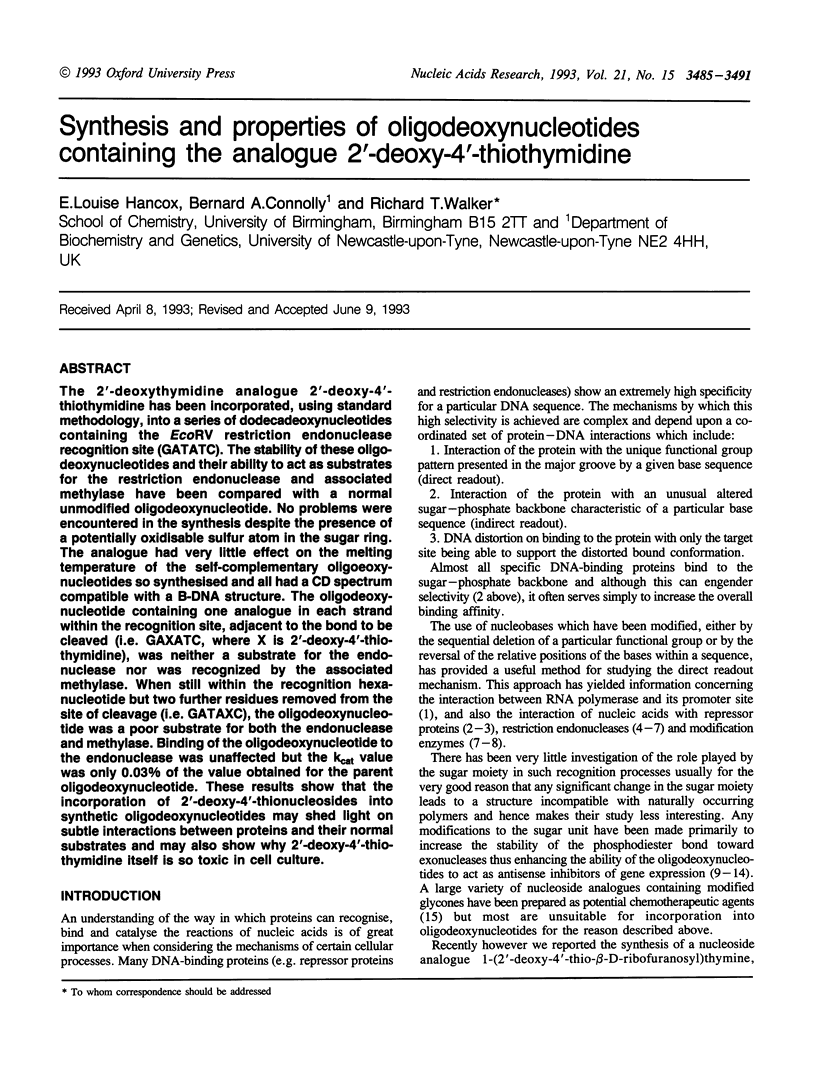
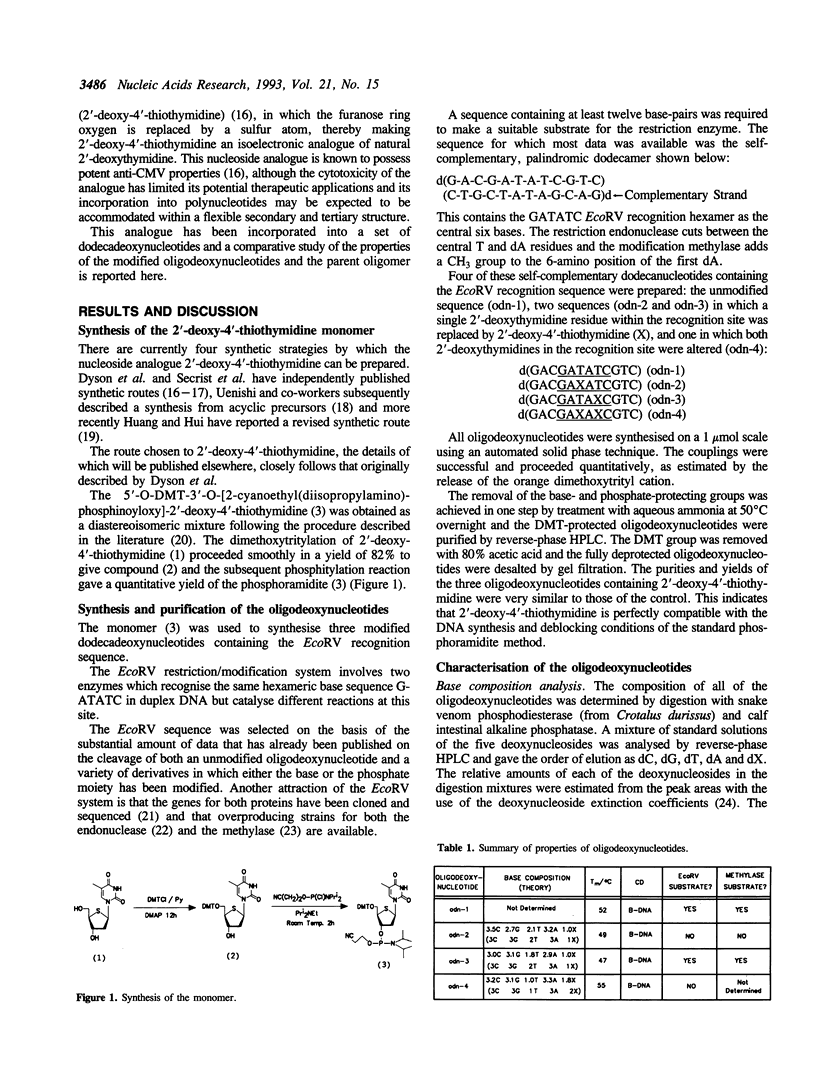
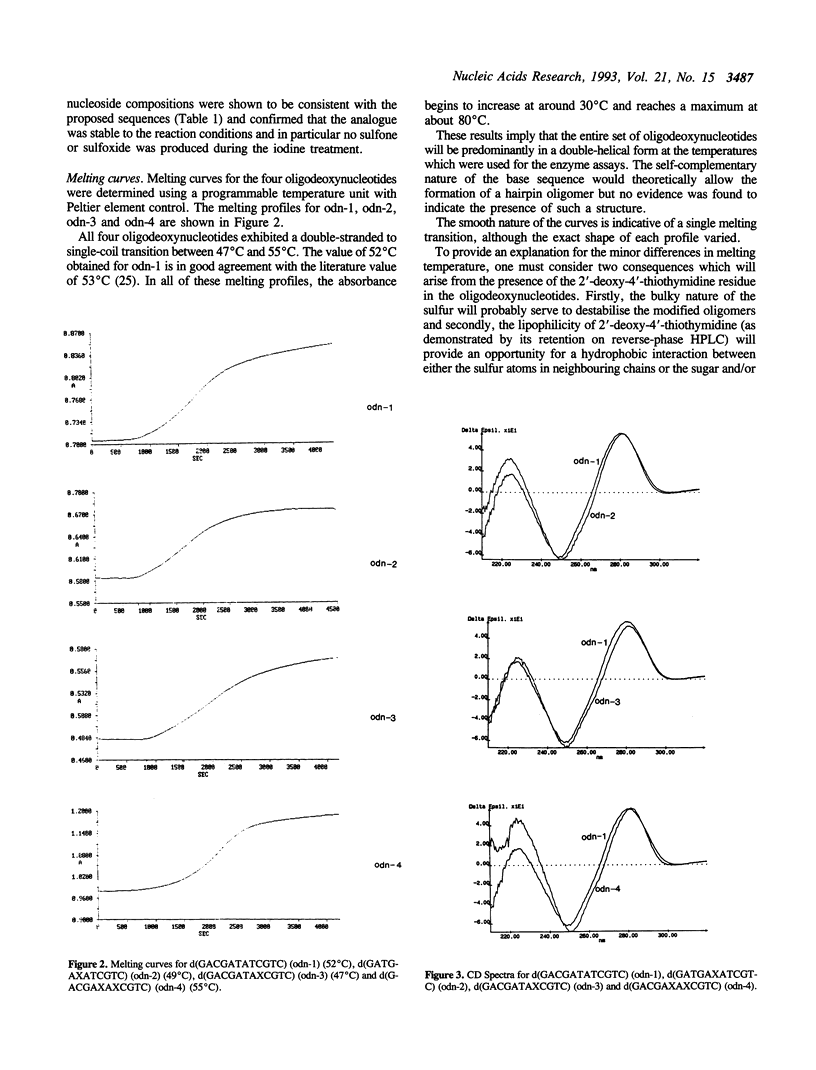
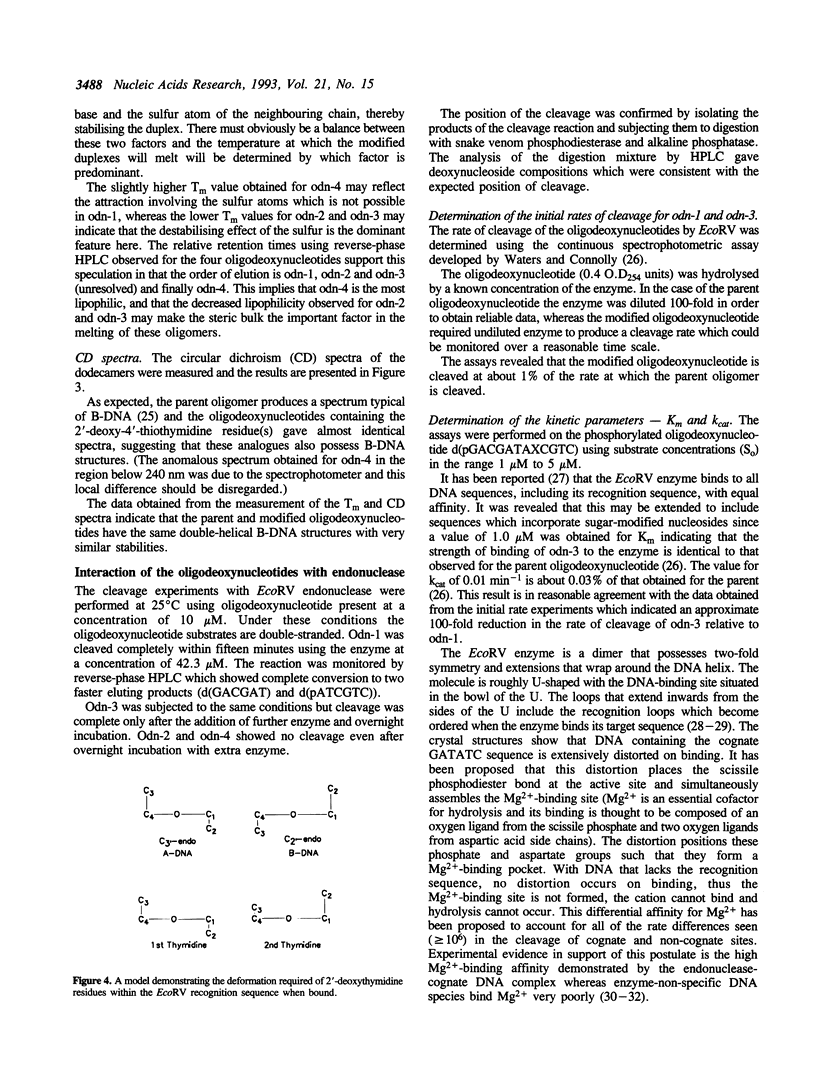
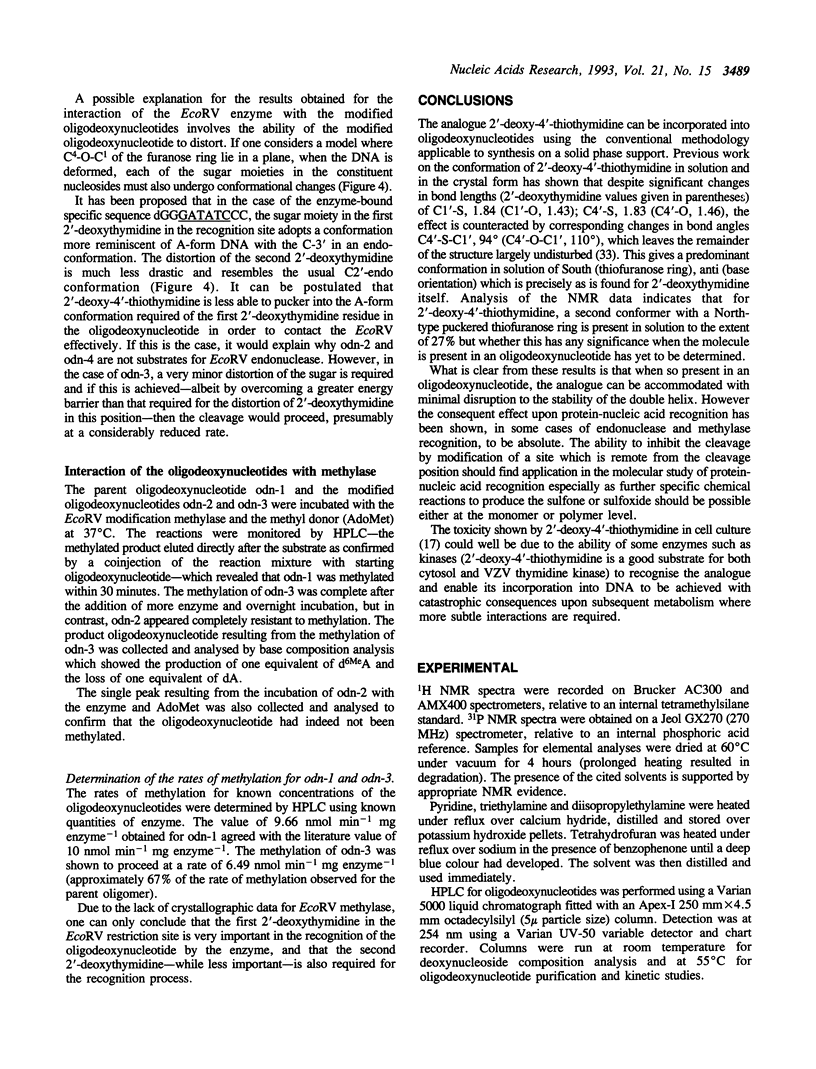
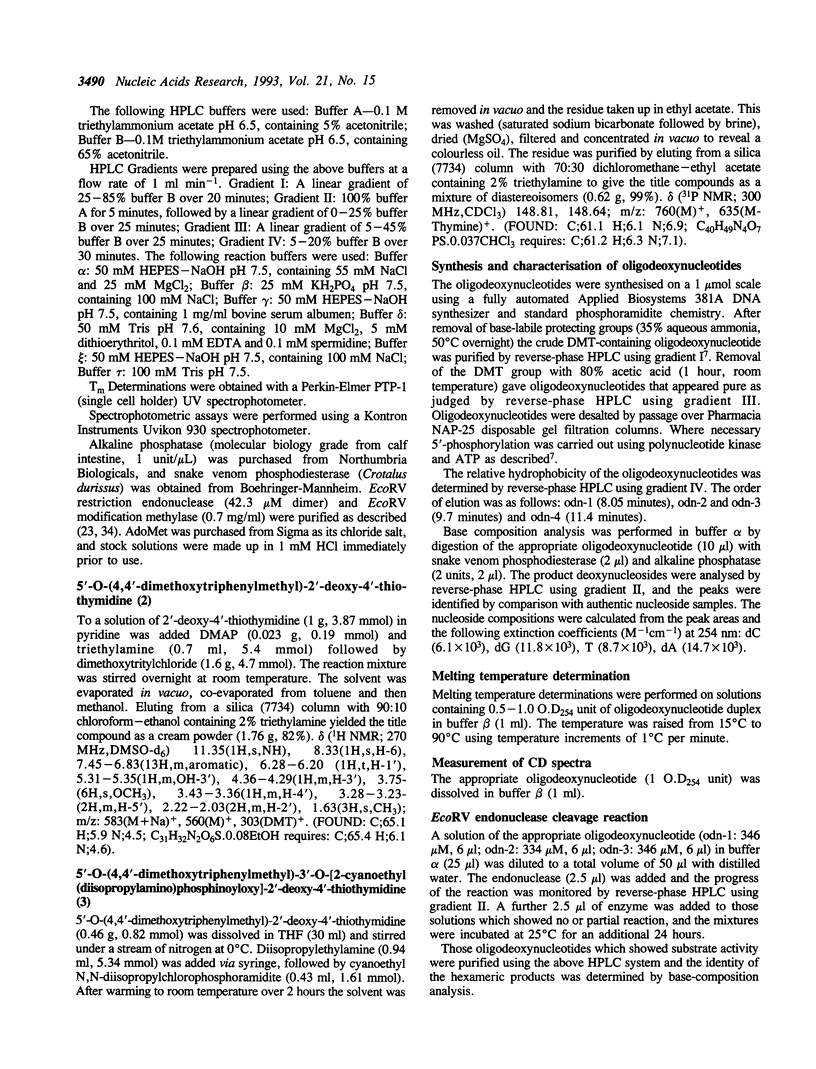
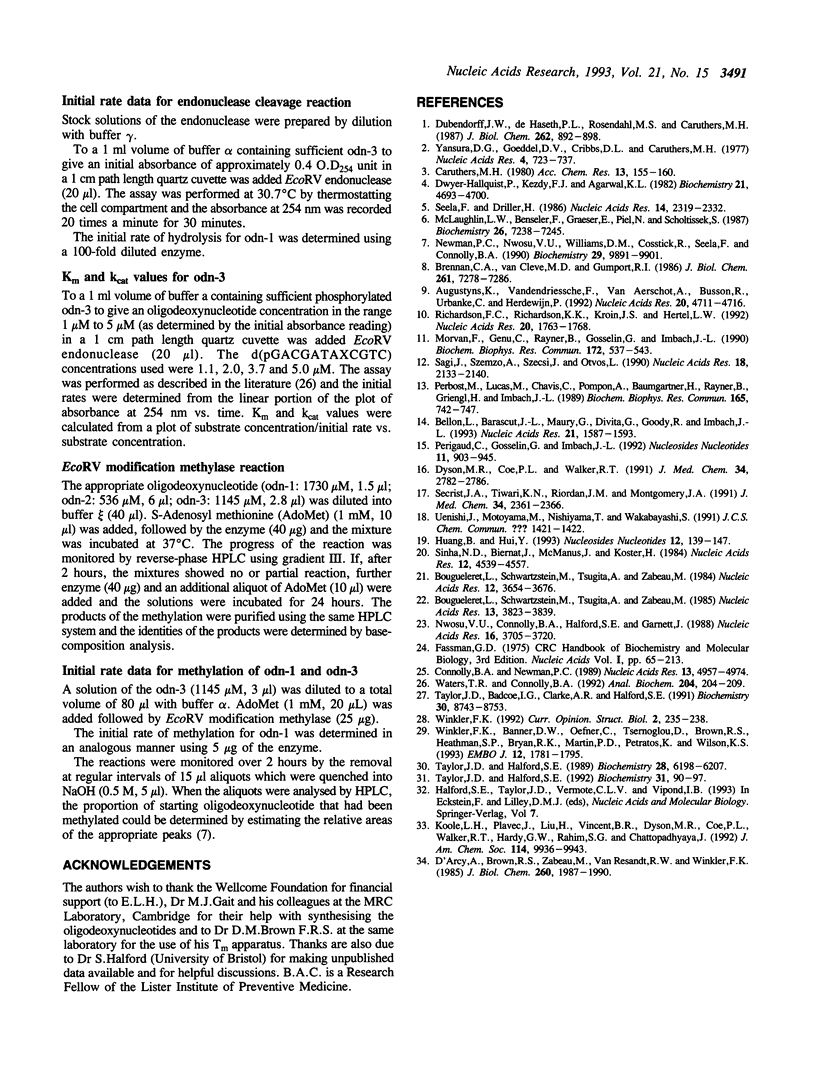
Selected References
These references are in PubMed. This may not be the complete list of references from this article.
- Augustyns K., Vandendriessche F., Van Aerschot A., Busson R., Urbanke C., Herdewijn P. Incorporation of hexose nucleoside analogues into oligonucleotides: synthesis, base-pairing properties and enzymatic stability. Nucleic Acids Res. 1992 Sep 25;20(18):4711–4716. doi: 10.1093/nar/20.18.4711. [DOI] [PMC free article] [PubMed] [Google Scholar]
- Bellon L., Barascut J. L., Maury G., Divita G., Goody R., Imbach J. L. 4'-Thio-oligo-beta-D-ribonucleotides: synthesis of beta-4'-thio-oligouridylates, nuclease resistance, base pairing properties, and interaction with HIV-1 reverse transcriptase. Nucleic Acids Res. 1993 Apr 11;21(7):1587–1593. doi: 10.1093/nar/21.7.1587. [DOI] [PMC free article] [PubMed] [Google Scholar]
- Bougueleret L., Schwarzstein M., Tsugita A., Zabeau M. Characterization of the genes coding for the Eco RV restriction and modification system of Escherichia coli. Nucleic Acids Res. 1984 Apr 25;12(8):3659–3676. doi: 10.1093/nar/12.8.3659. [DOI] [PMC free article] [PubMed] [Google Scholar]
- Bougueleret L., Tenchini M. L., Botterman J., Zabeau M. Overproduction of the EcoR V endonuclease and methylase. Nucleic Acids Res. 1985 Jun 11;13(11):3823–3839. doi: 10.1093/nar/13.11.3823. [DOI] [PMC free article] [PubMed] [Google Scholar]
- Brennan C. A., Van Cleve M. D., Gumport R. I. The effects of base analogue substitutions on the methylation by the EcoRI modification methylase of octadeoxyribonucleotides containing modified EcoRI recognition sequences. J Biol Chem. 1986 Jun 5;261(16):7279–7286. [PubMed] [Google Scholar]
- Connolly B. A., Newman P. C. Synthesis and properties of oligonucleotides containing 4-thiothymidine, 5-methyl-2-pyrimidinone-1-beta-D(2'-deoxyriboside) and 2-thiothymidine. Nucleic Acids Res. 1989 Jul 11;17(13):4957–4974. doi: 10.1093/nar/17.13.4957. [DOI] [PMC free article] [PubMed] [Google Scholar]
- D'Arcy A., Brown R. S., Zabeau M., van Resandt R. W., Winkler F. K. Purification and crystallization of the EcoRV restriction endonuclease. J Biol Chem. 1985 Feb 25;260(4):1987–1990. [PubMed] [Google Scholar]
- Dubendorff J. W., deHaseth P. L., Rosendahl M. S., Caruthers M. H. DNA functional groups required for formation of open complexes between Escherichia coli RNA polymerase and the lambda PR promoter. Identification via base analog substitutions. J Biol Chem. 1987 Jan 15;262(2):892–898. [PubMed] [Google Scholar]
- Dwyer-Hallquist P., Kézdy F. J., Agarwal K. L. Interaction of the HpaI endonuclease with synthetic oligonucleotides. Biochemistry. 1982 Sep 14;21(19):4693–4700. doi: 10.1021/bi00262a027. [DOI] [PubMed] [Google Scholar]
- Dyson M. R., Coe P. L., Walker R. T. The synthesis and antiviral activity of some 4'-thio-2'-deoxy nucleoside analogues. J Med Chem. 1991 Sep;34(9):2782–2786. doi: 10.1021/jm00113a016. [DOI] [PubMed] [Google Scholar]
- McLaughlin L. W., Benseler F., Graeser E., Piel N., Scholtissek S. Effects of functional group changes in the EcoRI recognition site on the cleavage reaction catalyzed by the endonuclease. Biochemistry. 1987 Nov 17;26(23):7238–7245. doi: 10.1021/bi00397a007. [DOI] [PubMed] [Google Scholar]
- Morvan F., Génu C., Rayner B., Gosselin G., Imbach J. L. Sugar modified oligonucleotides. III (1). Synthesis, nuclease resistance and base pairing properties of alpha- and beta-L-octathymidylates. Biochem Biophys Res Commun. 1990 Oct 30;172(2):537–543. doi: 10.1016/0006-291x(90)90706-s. [DOI] [PubMed] [Google Scholar]
- Newman P. C., Nwosu V. U., Williams D. M., Cosstick R., Seela F., Connolly B. A. Incorporation of a complete set of deoxyadenosine and thymidine analogues suitable for the study of protein nucleic acid interactions into oligodeoxynucleotides. Application to the EcoRV restriction endonuclease and modification methylase. Biochemistry. 1990 Oct 23;29(42):9891–9901. doi: 10.1021/bi00494a020. [DOI] [PubMed] [Google Scholar]
- Nwosu V. U., Connolly B. A., Halford S. E., Garnett J. The cloning, purification and characterization of the Eco RV modification methylase. Nucleic Acids Res. 1988 May 11;16(9):3705–3720. doi: 10.1093/nar/16.9.3705. [DOI] [PMC free article] [PubMed] [Google Scholar]
- Perbost M., Lucas M., Chavis C., Pompon A., Baumgartner H., Rayner B., Griengl H., Imbach J. L. Sugar modified oligonucleotides. I. Carbo-oligodeoxynucleotides as potential antisense agents. Biochem Biophys Res Commun. 1989 Dec 15;165(2):742–747. doi: 10.1016/s0006-291x(89)80029-4. [DOI] [PubMed] [Google Scholar]
- Richardson F. C., Richardson K. K., Kroin J. S., Hertel L. W. Synthesis and restriction enzyme analysis of oligodeoxyribonucleotides containing the anti-cancer drug 2',2'-difluoro-2'-deoxycytidine. Nucleic Acids Res. 1992 Apr 11;20(7):1763–1768. doi: 10.1093/nar/20.7.1763. [DOI] [PMC free article] [PubMed] [Google Scholar]
- Secrist J. A., 3rd, Tiwari K. N., Riordan J. M., Montgomery J. A. Synthesis and biological activity of 2'-deoxy-4'-thio pyrimidine nucleosides. J Med Chem. 1991 Aug;34(8):2361–2366. doi: 10.1021/jm00112a007. [DOI] [PubMed] [Google Scholar]
- Seela F., Driller H. Palindromic oligonucleotides containing 7-deaza-2'-deoxyguanosine: solid-phase synthesis of d[(p)GG*AATTCC] octamers and recognition by the endodeoxyribonuclease EcoRI. Nucleic Acids Res. 1986 Mar 11;14(5):2319–2332. doi: 10.1093/nar/14.5.2319. [DOI] [PMC free article] [PubMed] [Google Scholar]
- Sinha N. D., Biernat J., McManus J., Köster H. Polymer support oligonucleotide synthesis XVIII: use of beta-cyanoethyl-N,N-dialkylamino-/N-morpholino phosphoramidite of deoxynucleosides for the synthesis of DNA fragments simplifying deprotection and isolation of the final product. Nucleic Acids Res. 1984 Jun 11;12(11):4539–4557. doi: 10.1093/nar/12.11.4539. [DOI] [PMC free article] [PubMed] [Google Scholar]
- Sági J., Szemzõ A., Szécsi J., Otvös L. Biochemical properties of oligo [(+)-carbocyclic-thymidylates] and their complexes. Nucleic Acids Res. 1990 Apr 25;18(8):2133–2140. doi: 10.1093/nar/18.8.2133. [DOI] [PMC free article] [PubMed] [Google Scholar]
- Taylor J. D., Badcoe I. G., Clarke A. R., Halford S. E. EcoRV restriction endonuclease binds all DNA sequences with equal affinity. Biochemistry. 1991 Sep 10;30(36):8743–8753. doi: 10.1021/bi00100a005. [DOI] [PubMed] [Google Scholar]
- Taylor J. D., Halford S. E. Discrimination between DNA sequences by the EcoRV restriction endonuclease. Biochemistry. 1989 Jul 25;28(15):6198–6207. doi: 10.1021/bi00441a011. [DOI] [PubMed] [Google Scholar]
- Taylor J. D., Halford S. E. The activity of the EcoRV restriction endonuclease is influenced by flanking DNA sequences both inside and outside the DNA-protein complex. Biochemistry. 1992 Jan 14;31(1):90–97. doi: 10.1021/bi00116a014. [DOI] [PubMed] [Google Scholar]
- Waters T. R., Connolly B. A. Continuous spectrophotometric assay for restriction endonucleases using synthetic oligodeoxynucleotides and based on the hyperchromic effect. Anal Biochem. 1992 Jul;204(1):204–209. doi: 10.1016/0003-2697(92)90162-z. [DOI] [PubMed] [Google Scholar]
- Winkler F. K., Banner D. W., Oefner C., Tsernoglou D., Brown R. S., Heathman S. P., Bryan R. K., Martin P. D., Petratos K., Wilson K. S. The crystal structure of EcoRV endonuclease and of its complexes with cognate and non-cognate DNA fragments. EMBO J. 1993 May;12(5):1781–1795. doi: 10.2210/pdb4rve/pdb. [DOI] [PMC free article] [PubMed] [Google Scholar]
- Yansura D. G., Goeddel D. V., Cribbs D. L., Caruthers M. H. Studies of gene control regions. III. Binding of synthetic and modified synthetic lac operator DNAs to lactose repressor. Nucleic Acids Res. 1977 Mar;4(3):723–737. doi: 10.1093/nar/4.3.723. [DOI] [PMC free article] [PubMed] [Google Scholar]


